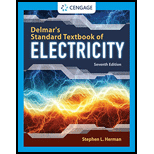
Delmar's Standard Textbook Of Electricity
7th Edition
ISBN: 9781337900348
Author: Stephen L. Herman
Publisher: Cengage Learning
expand_more
expand_more
format_list_bulleted
Concept explainers
Textbook Question
Chapter 12, Problem 4RQ
What is a battery?
Expert Solution & Answer
Want to see the full answer?
Check out a sample textbook solution
Students have asked these similar questions
NO AI PLEASE
A DPSK has the following data input: d(n) =101011010001
1. Find the output coded sequence and the carrier phase.
2. Recover the input data from the output coded sequence.
I need help with this problem and an step by step explanation of the solution from the image described below. (Introduction to Signals and Systems)
Chapter 12 Solutions
Delmar's Standard Textbook Of Electricity
Ch. 12 - 1. What is a voltaic cell?
Ch. 12 - What factors determine the amount of voltage...Ch. 12 - What determines the amount of current a cell can...Ch. 12 - 4. What is a battery?
Ch. 12 - 5. What is a primary cell?
Ch. 12 - What is a secondary cell?Ch. 12 - 7. What material is used as the positive electrode...Ch. 12 - What is another name for the Leclanch cell?Ch. 12 - 9. What is used as the electrolyte in a...Ch. 12 - What is the advantage of the alkaline cell as...
Ch. 12 - What material is used as the positive electrode in...Ch. 12 - 12. How is the A-hr capacity of a lead-acid...Ch. 12 - What device is used to test the specific gravity...Ch. 12 - 14. A 6-V lead-acid battery has an A-hr rating of...Ch. 12 - Three 12-V, 100-A-hr batteries are connected in...Ch. 12 - What is the voltage produced by a silicon solar...Ch. 12 - What determines the current capacity of a solar...Ch. 12 - A solar cell can produce a voltage of 0.5 V and...Ch. 12 - Prob. 19RQCh. 12 - Prob. 20RQCh. 12 - Prob. 21RQCh. 12 - Prob. 22RQCh. 12 - Your job is to order and connect lead-acid cells...Ch. 12 - A bank of nickel-cadmium cells is used as the...Ch. 12 - An office building uses a bank of 63 lead-acid...
Knowledge Booster
Learn more about
Need a deep-dive on the concept behind this application? Look no further. Learn more about this topic, electrical-engineering and related others by exploring similar questions and additional content below.Similar questions
- Note that all capacitors are large so that their impedance is negligible at signal frequencies of interest. npn equations active Ic Ise VBE/VT = IB = (Is/B)eVB VBE/VT IE = (Is/α)еVB VBE/VT Ic=ẞIB_IС = αIE B α α = B = B+1 1-α Ic α Im Υπ re To= VT 9m Im 550 VAarrow_forwardi need help insolving the following question pleasearrow_forwardi need help insolving the following question pleasearrow_forward
- NO AI. NEED EXPLANATION ALSO PLEASEarrow_forwardI need help with this problem and an step by step explanation of the solution from the image described below. (Introduction to Signals and Systems)arrow_forwardI need help with this problem and an step by step explanation of the solution from the image described below. (Introduction to Signals and Systems)arrow_forward
- 10.49 Using source transformation, find i in the circuit of Fig. 10.94. 5 Ω www 3Ω 5 mH 8 sin(200t+30°) A 1 mFarrow_forwardThis exam is closed book, but you may use one 8.5x11" sheet of notes (both sides), handwritten by you Wote all answers kot on this test paper! Use the personal key number N (written above) on the parameters se fix to Show your work and explain your reasoning Partial credit will be given for partial solutions. When giving a numerical answer, specify units ill any apply. No credit will be given for solving problems from previous 1. For the AM signal with periodic message m() shown in Fig. 1 and modulation index = 0.03A a) find the carrier amplitude and carrier power; b) find the sideband power and compute the power efficiency & N = 15 4+N AA -(4+N) Fig. 1 r(s)→arrow_forward1. Tests of a 10 kVA, 230/2300 V single-phase transformer have yielded the following results: Vacuum test low voltage side: current = 0.45A Po = 70WLow side short circuit test: voltage = 11.6V Pcc = 224.3WDetermine: a. Parameters Rcc and Xcc of the equivalent circuit referring to the secondary.b. Transformer voltage regulation, if feeding a load of 4kVA, fp = 0.75 in delayc. Efficiency if the load is 7kVA, fp = 0.8 inductiveperform the calculations without using artificial intelligence, let it be by one of the assigned people pleasearrow_forward
arrow_back_ios
SEE MORE QUESTIONS
arrow_forward_ios
Recommended textbooks for you
 Electricity for Refrigeration, Heating, and Air C...Mechanical EngineeringISBN:9781337399128Author:Russell E. SmithPublisher:Cengage Learning
Electricity for Refrigeration, Heating, and Air C...Mechanical EngineeringISBN:9781337399128Author:Russell E. SmithPublisher:Cengage Learning Delmar's Standard Textbook Of ElectricityElectrical EngineeringISBN:9781337900348Author:Stephen L. HermanPublisher:Cengage Learning
Delmar's Standard Textbook Of ElectricityElectrical EngineeringISBN:9781337900348Author:Stephen L. HermanPublisher:Cengage Learning

Electricity for Refrigeration, Heating, and Air C...
Mechanical Engineering
ISBN:9781337399128
Author:Russell E. Smith
Publisher:Cengage Learning

Delmar's Standard Textbook Of Electricity
Electrical Engineering
ISBN:9781337900348
Author:Stephen L. Herman
Publisher:Cengage Learning
What is an electric furnace and how does it work?; Author: Fire & Ice Heating and Air Conditioning Inc;https://www.youtube.com/watch?v=wjAWecPGi0M;License: Standard Youtube License